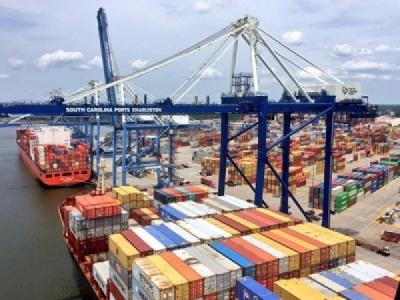
Posted on August 17, 2017
By Hailey Desormeaux, American Shipper
South Carolina Ports Authority (SCPA), which owns and operates public seaport facilities in Charleston, Georgetown and Greer, handled 1.3 million TEUs during the first seven months of 2017, up 13 percent year-over-year, SCPA said Monday.
In July alone, SCPA moved 182,411 TEUs, the strongest July on record and an increase of 2.9 percent from 12 months prior.
Inland Port Greer handled 74,700 rail moves during the first seven months of 2017, rising 31.4 percent year-over-year.
Looking ahead, the project to deepen the main channel in Charleston from 45 feet to 52 feet, which will allow neo-Panamax vessels of 14,000 TEUs or more to enter the Port of Charleston without tidal restrictions, is still on track to begin this fall, SCPA said. Erin Dhand, manager, corporate communications and community affairs at SCPA, told American Shipper back in May the project is expected to be completed in 2020.
The project received $17.5 million in construction funding in the U.S. Army Corps of Engineers Fiscal 2017 Work Plan that was released in May. In addition, the South Carolina legislature appropriated $300 million for the Charleston Harbor Deepening Project in 2012.
“The USACE solicited bids for the Post 45 Charleston Entrance Channel Maintenance and New Work Dredging – Contract One in June, and the apparent low bidder for the contract is Great Lakes Dredge & Dock Company, LLC, with a bid of $47,197,150,” SCPA said Monday. “The USACE Charleston District still needs to complete several acquisition steps to verify the acceptability of the bid prior to award of this contract, which is planned for next month. Contract 1 is the smaller of two contracts required to complete the Entrance Channel deepening construction.”
According to ocean carrier schedule and capacity database BlueWater Reporting’s Port Dashboard tool, the Port of Charleston is called by 30 liner services connecting it to ports outside of North America: 24 deploying fully cellular container vessels, five deploying pure car/truck carriers and one deploying multi-purpose vessels.
Source: American Shipper





